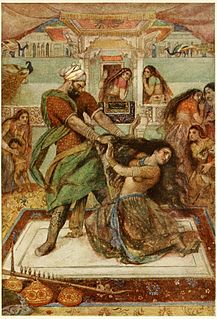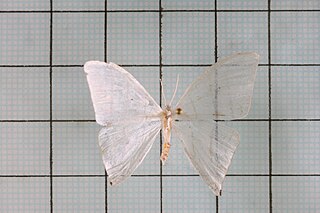
In Hindu epic Mahabharata, Bhima is the second among the five Pandavas. The Mahabharata relates many events that portray the might of Bhima. Bhima was born when Vayu, the wind god, granted a son to Kunti and Pandu. After the death of Pandu and Madri, Kunti with her sons stayed in Hastinapura. From his childhood, Bhima had a rivalry with his cousins Kauravas, especially Duryodhana. Duryodhana and his uncle, Shakuni, tried to kill Bhima multiple times. One was by poisoning and throwing Bhima into a river. Bhima was rescued by Nāgas and was given a drink which made him very strong and immune to all venom.

Dushasana, also spelled as Dussasana and Duhsasana, is an antagonist of the Hindu epic, Mahabharata. He was one of the Kaurava princes and the younger brother of Duryodhana.

The Bhima River is a major river in Western India and South India. It flows southeast for 861 kilometres (535 mi) through Maharashtra, Karnataka, and Telangana states, before entering the Krishna River. After the first sixty-five kilometers in a narrow valley through rugged terrain, the banks open up and form a fertile agricultural area which is densely populated.

Hidimba Devi Temple, locally known as Dhungari Temple, also known variously as the Hadimba Temple, is located in Manāli, a hill station in the State of Himāchal Pradesh in north India. It is an ancient cave temple dedicated to Hidimbi Devi, wife of Bhima, a figure in the Indian epic Mahābhārata. The temple is surrounded by a cedar forest called Dhungiri Van Vihar at the foot of the Himālayas. The sanctuary is built over a huge rock jutting out of the ground which was worshiped as an image of the deity. The structure was built in 1553 by Maharaja Bahadur Singh.

Red-bodied swallowtails or ruby swallowtail are butterflies in the swallowtail family, that belong to the genera Atrophaneura, Byasa, Losaria, or Pachliopta. They are generally found in Asia.

Randamoozham is a 1984 Malayalam novel by Indian author M. T. Vasudevan Nair, widely credited as his masterpiece. The work won the Vayalar Award, given for the best literary work in Malayalam, in 1985. It also won the Muttathu Varkey Award in 1994. The novel has been translated to multiple languages. It was translated into English as Second Turn in 1997. Another English translation by Gita Krishnankutty published in 2013 is titled Bhima: Lone Warrior.

Amphipyra is a genus of moths. It is the only genus remaining in the subfamily Amphipyrinae, the others having been removed, e.g., to the Hadeninae.

Bhima Bhoi (1850–1895) was a saint, poet and philosopher from the state of Odisha in India. Bhima Bhoi was a bhakta of Mahima Swamy. From Mahima Swamy, Bhima Bhoi would receive initiation into Mahima Dharma, an Indian religious tradition that challenged the authority of caste Hinduism on its own terms.

Omiodes is a moth genus in the family Crambidae. Several species are endemic to Hawaii.

Palpita is a genus of moths of the family Crambidae. Members of the moth genus Stemorrhages may be very similar in appearance.

Patania is a genus of moths of the family Crambidae described by Frederic Moore in 1888.

Synclera is a genus of moths of the family Crambidae described by Julius Lederer in 1863.
Hastina is a genus of moths in the family Geometridae.

Perizoma is a genus in the geometer moth family (Geometridae). It is the type genus of tribe Perizomini in subfamily Larentiinae. The tribe is considered monotypic by those who include the genera Gagitodes, Martania and Mesotype in Perizoma. Some other less closely related species formerly placed here are now elsewhere in the Larentiinae, e.g. in Entephria of the tribe Larentiini.

Ditrigona is a genus of moths belonging to the subfamily Drepaninae. The genus was erected by Frederic Moore in 1888.

Asthenini is a tribe of geometer moths under subfamily Larentiinae first described by Warren in 1893. The tribe has been combined with Eupitheciini in the past, most notably by Jeremy Daniel Holloway in his work The Moths of Borneo.

Habrosyne is a genus of moths belonging to the family Drepanidae. It was first described by Jacob Hübner in 1816.

Thalaivaa (transl. Leader) is a 2013 Indian Tamil-language action thriller film written and directed by A. L. Vijay. It stars Vijay in the title role, Amala Paul, Sathyaraj, with Abhimanyu Singh, Santhanam and Ragini Nandwani, in supporting roles. The film, produced by Chandraprakash Jain, features background score and soundtrack composed by G. V. Prakash Kumar with cinematography and editing handled by Nirav Shah and Anthony respectively. The story revolves around a dancer who takes over his father's duty as a crime boss after his death.

The 2018 Bhima Koregaon violence refers to violence during an annual celebratory gathering on 1 January 2018 at Bhima Koregaon to mark the 200th anniversary of the Battle of Bhima Koregaon. The violence and stone pelting by anti-social elements on the gathering resulted in death of a 28-year old youth and injury to five others. The annual celebration, also called Elgar Parishad convention, was organised by retired justices B. G. Kolse Patil and P. B. Sawant. Justice P. B. Sawant claimed that the term "Elgar" meant loud invitation or loud declaration.
This page is based on this
Wikipedia article Text is available under the
CC BY-SA 4.0 license; additional terms may apply.
Images, videos and audio are available under their respective licenses.


















